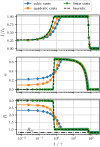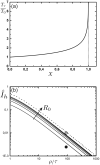A control theory approach to optimal pandemic mitigation
- PMID: 33606802
- PMCID: PMC7894916
- DOI: 10.1371/journal.pone.0247445
A control theory approach to optimal pandemic mitigation
Erratum in
-
Correction: A control theory approach to optimal pandemic mitigation.PLoS One. 2024 Dec 10;19(12):e0315749. doi: 10.1371/journal.pone.0315749. eCollection 2024. PLoS One. 2024. PMID: 39656724 Free PMC article.
Abstract
In the framework of homogeneous susceptible-infected-recovered (SIR) models, we use a control theory approach to identify optimal pandemic mitigation strategies. We derive rather general conditions for reaching herd immunity while minimizing the costs incurred by the introduction of societal control measures (such as closing schools, social distancing, lockdowns, etc.), under the constraint that the infected fraction of the population does never exceed a certain maximum corresponding to public health system capacity. Optimality is derived and verified by variational and numerical methods for a number of model cost functions. The effects of immune response decay after recovery are taken into account and discussed in terms of the feasibility of strategies based on herd immunity.
Conflict of interest statement
The authors have declared that no competing interests exist.
Figures






References
-
- World Health Organization. Report of the who-china joint mission on coronavirus disease 2019 (covid-19); 2020. Available from: https://www.who.int/docs/default-source/coronaviruse/who-china-joint-mis....
-
- Hethcote HW. The mathematics of infectiuous diseases. SIAM Review. 2000;42:599–653. 10.1137/S0036144500371907 - DOI
-
- Harko T, Lobo FSN, Mak MK. Exact analytical solutions of the Susceptible-Infected-Recovered (SIR) epidemic model and of the SIR model with equal death and birth rates. Applied Mathematics and Computation. 2014;236:184–194. 10.1016/j.amc.2014.03.030 - DOI
Publication types
MeSH terms
LinkOut - more resources
Full Text Sources
Other Literature Sources

